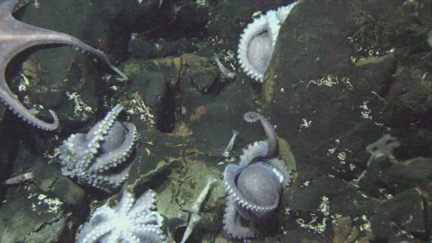Playing It Cool at Ocean Vents
“Black smokers,” or high-temperature hydrothermal vents at the bottom of the ocean, have generated a lot of scientific interest since they were discovered forty years ago. By belching hot, mineral-laden water, these vents support communities of microbes and animals far from sunlight.
But not all ocean vents are hot. Cool hydrothermal systems, or cool vents, are much harder to spot because the fluids they release are clear and only a bit warmer than surrounding water. Yet they could play a major role in releasing minerals into the deep ocean.

Now researchers including Laura Zinke, now a postdoctoral researcher at UC Davis in the Department of Earth and Planetary Sciences, have published the first survey of the microbes living near a cool vent.
The researchers worked at the Dorado Outcrop, about 3,000 meters deep off the coast of Costa Rica. The Dorado Outcrop and its cool vent was discovered by Beth Orcutt of the Bigelow Laboratory for Ocean Sciences and C. Geoffrey Wheat, University of Alaska, in 2013. Orcutt described the vent as a “soaker hose” of fluid spilling from the crust in faint shimmering streams. Octopuses gather in large numbers at the outcrop to incubate their eggs in the warm water, 10 to 15 degrees Celsius compared to 2 degrees in the surrounding area.
The team used the Deep Sea Vehicle Alvin to explore the outcrop and collect sediment cores. Back on the research vessel Atlantis, Zinke sorted through the microbes from the mud by gene sequencing.
She found that the community of microbes at the vent was similar to that in other deep sea sediments, but enriched in microbes involved in nitrogen cycling, possibly because of nitrates released from the vent.
This additional nitrogen cycling might mean that the vent microbial community can also grow faster and take up more carbon from the ocean water. So these cool vent communities could be playing a previously hidden role in cycling both nitrogen and carbon.
Additional authors on the paper, published June 13 in Frontiers in Microbiology, are Brandi Riese, Texas A&M University; James McManus, Bigelow Laboratory for Ocean Sciences and University of Akron, Ohio; and Jan Amend, University of Southern California. Zinke carried out the work as a graduate student in Amend’s laboratory at USC.
The research was a project of the Deep Carbon Observatory Census of Deep Life, funded by the Alfred P. Sloan Foundation. Research cruises were supported by the National Science Foundation.
— Andy Fell, UC Davis News and Media Relations
